Introduction: In this article, Melissa Davenport Berry explores the history and family lore of the Fuller cradle, the Pilgrim cradle displayed at the Pilgrim Hall Museum. Melissa is a genealogist who has a website, americana-archives.com, and a Facebook group, New England Family Genealogy and History.
Today I continue exploring the relics of the Mayflower, focusing on the Fuller cradle which is now housed at Pilgrim Hall Museum in Plymouth, Massachusetts.
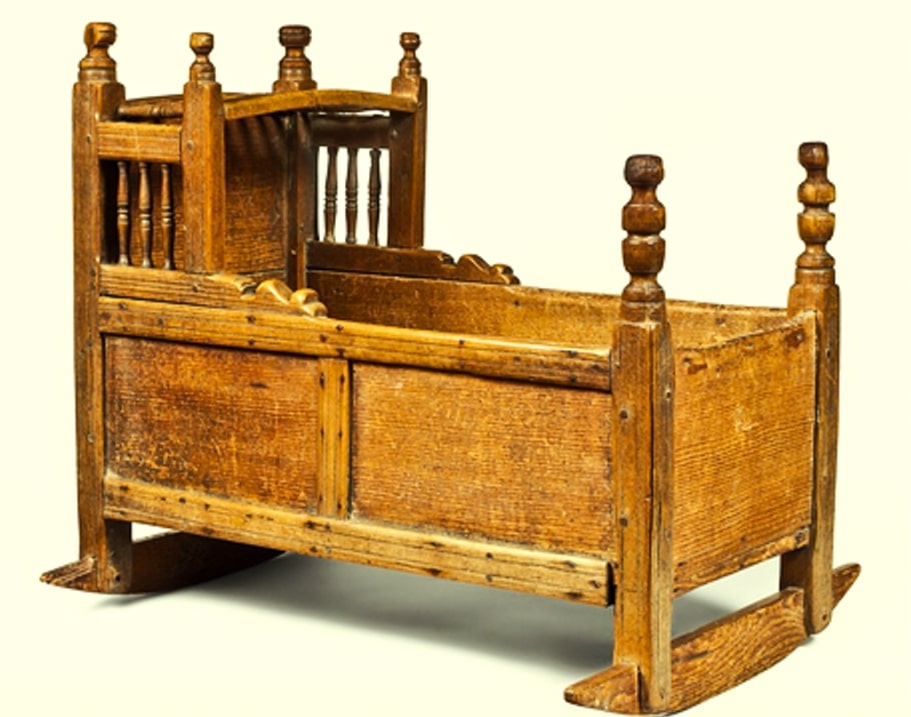
In 1860 the Fuller cradle was mentioned in a Massachusetts newspaper.
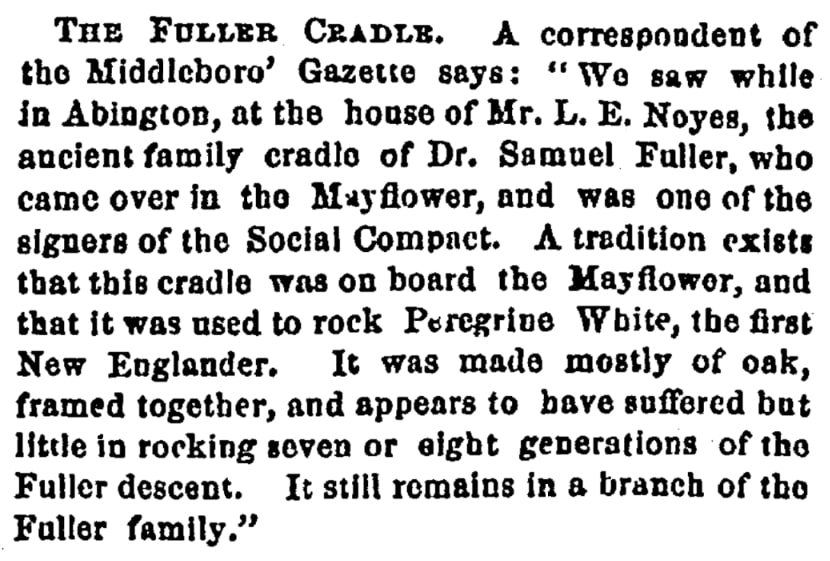
To recap: My last story featured the Allerton-Cushman families’ wooden cup, which is an example of a relic with a reliable provenance through a recorded inventory. Additionally, I covered a writing desk claimed to be owned by John Alden, and a few cradles purported to have made the journey across the Atlantic on the Mayflower in 1620.
At the time of the Salem Register article above, the cradle was in the possession of a direct descendant of Dr. Samuel Fuller: Lewis Ellingwood Noyes (1823-1916), son of Jacob and Olive (Edson) Noyes, who lived in Abington, Massachusetts.
Later that year the cradle was placed on exhibit at the Huntington Hall in Lowell, Massachusetts, located by the Hurd Street Methodist Church.
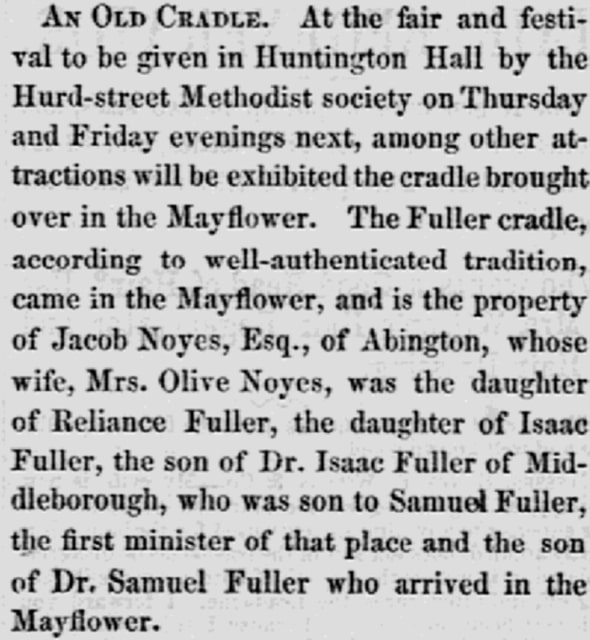
According to this news clip, it is a:
…well authenticated tradition [that the Fuller cradle] came in the Mayflower, and is the property of Jacob Noyes, Esq., of Abington, whose wife, Mrs. Olive Noyes, was the daughter of Reliance Fuller, the daughter of Isaac Fuller, the son of Dr. Isaac Fuller of Middleborough, who was son to Samuel Fuller, the first minister of that place and the son of Dr. Samuel Fuller who arrived in the Mayflower.
In this illustration by W. L Hudson of a “New England Pioneer Home” we see a cradle obviously based on the Fuller cradle. This drawing is found in Edward Sylvester Ellis’ The National History of the United States; from the Landing of the Norsemen to the Present Time, Volume 1, 1899.
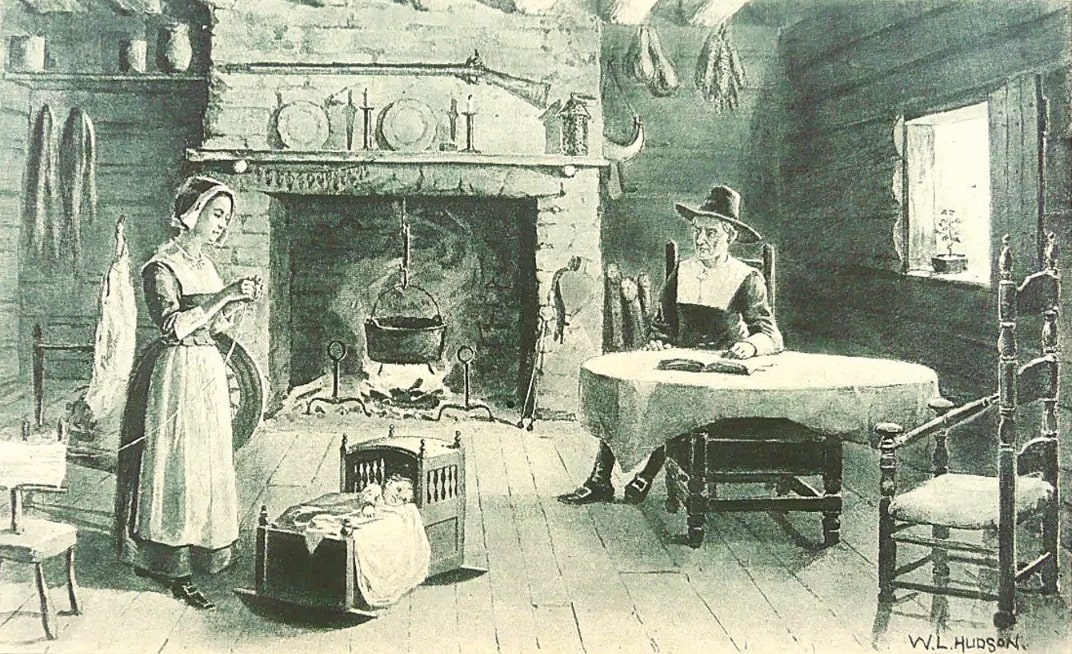
From more research I found the cradle went to Miss Elise Noyes, daughter of Lewis Ellington Noyes, who presented the cradle to Pilgrim Hall Museum.
Later the heirs of Henry Augustus Noyes (1820-1889), brother to Lewis Ellington Noyes who lived in Omaha, Nebraska, would rock their son Thomas Reynolds Porter Jr., aka “Tom Tom” Porter, in the cradle in 1920 at the Plymouth Tercentenary Commemoration of the landing of the first Pilgrims.
Here is the announcement from the Boston Herald.
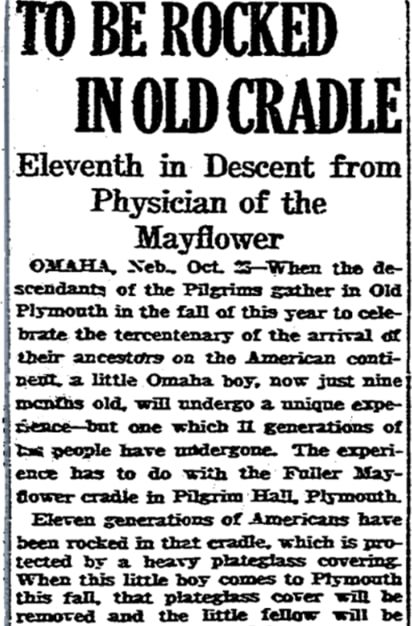
This article reports:
Eleven generations of Americans have been rocked in that [Fuller] cradle, which is protected by a heavy plateglass covering. When this little boy comes to Plymouth this fall, that plateglass cover will be removed and the little fellow will be rocked in the cradle of his ancestors. Then the covering will be replaced, probably not to be removed for another generation.
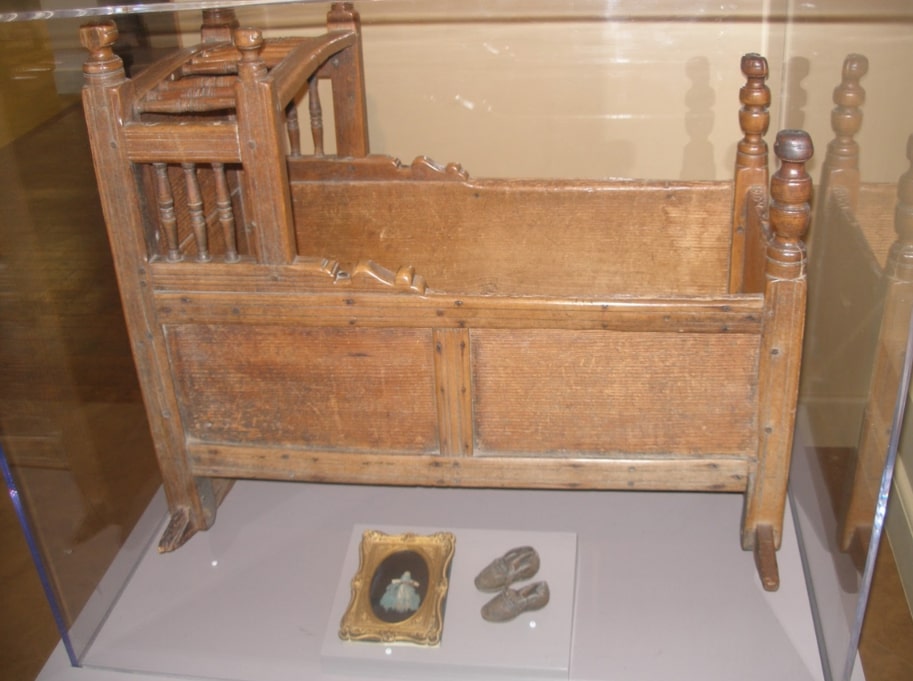
According to the Boston Herald article, an agreement was made by the donor Elise Noyes with Pilgrim Hall Museum. The cradle was donated to the museum with one condition: if any descendant of Samuel Fuller wishes to rock their baby in the cradle the museum must allow it and on their dime for all expenses.
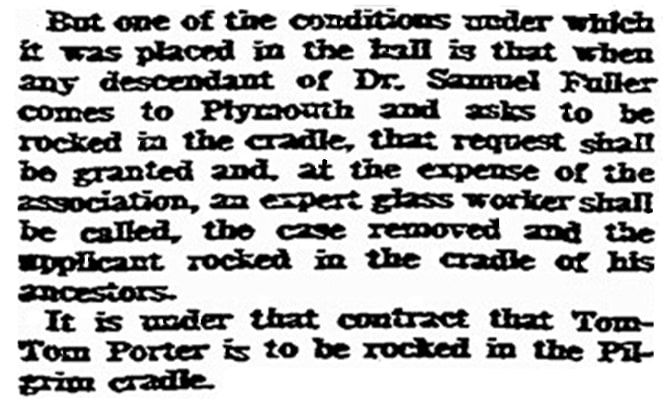
The article also reports:
It is under that contract that Tom Tom Porter is to be rocked in the Pilgrim cradle.
Below is a newspaper photo of Tom Tom with his mother, Mrs. Thomas R. Porter, celebrating their Mayflower history. Read more about this Fuller line here: Mayflower Who’s Who Part 13.
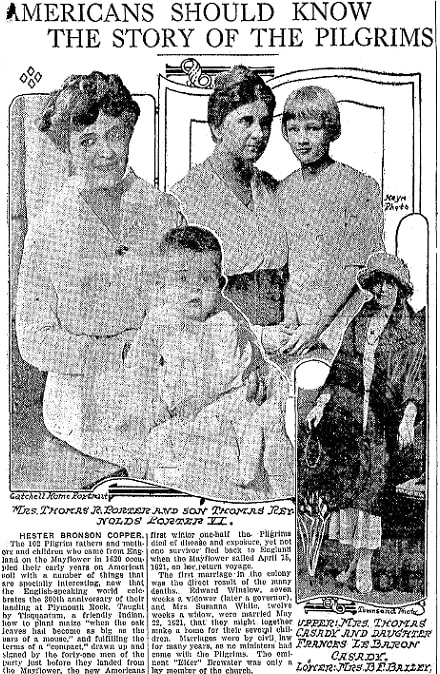
The photo caption on the left reads:
Mrs. Thomas R. Porter and son Thomas Reynolds Porter VI.
The photo caption on the right reads:
Upper: Mrs. Thomas Casady and daughter Frances Le Baron Casady. Lower: Mrs. B. E. Bailey.
Here is a photo of the Dr. Samuel Fuller historical marker, along with the lineage of this Fuller family line. The historical marker is on the side of the house shown below, on Leyden Street in Plymouth, Massachusetts.
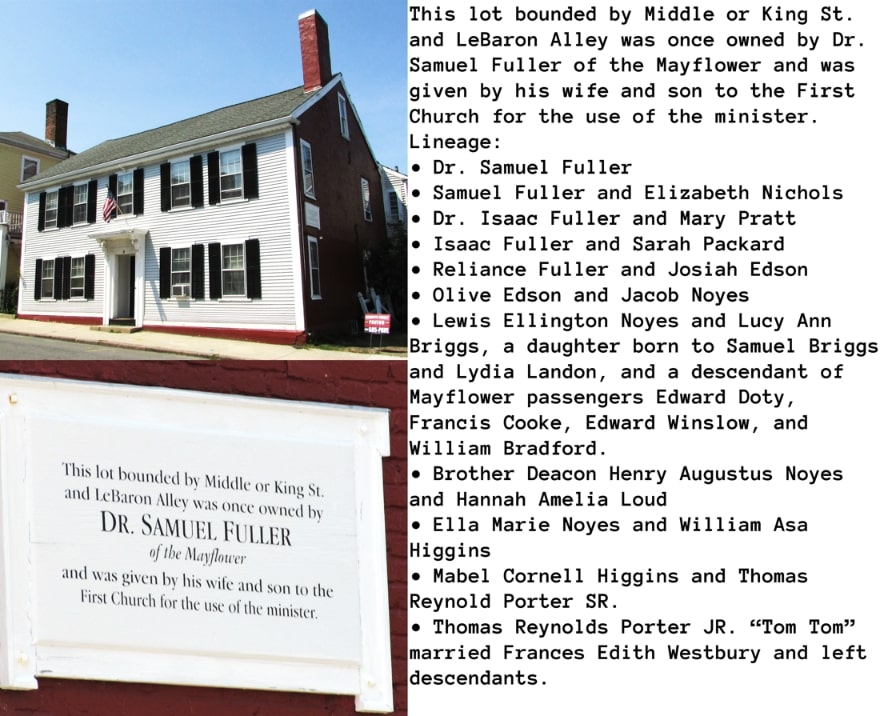
Conflicting Antiquity
In 1930 the Fuller cradle was rocked with a great debate over its authenticity when a well-known private collector, Wallace Nutting, claimed that he had the real Fuller cradle, not the one displayed in the Pilgrim Hall Museum.
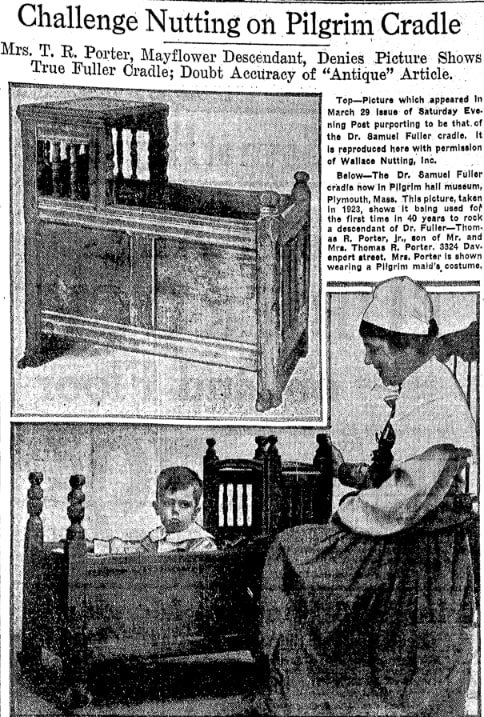
This feature article presents an image (top) of a cradle owned by Wallace Nutting, while the bottom photo shows the real Fuller cradle at Pilgrim Hall with little “Tom Tom” rocking away with his mother in 1923 – the same cradle he was first rocked in at the tercentenary commemoration in 1920.
After much research and debate, this cradle controversy was successfully clarified and it was with the help of genealogical data, family history, and the confirmation from Henry W. Royal, curator of Pilgrim Hall, that the true provenance of this relic was established and the Fuller cradle at the Plymouth museum was determined to be the authentic item.
Unfortunately, Mr. Nutting had a hard time letting his claim go, but it may be he was frustrated because he had purchased his cradle for $250 from Chauncey Cushing Nash. That is a whole other story, but it seems this particular cradle was loaned out on exhibit by Mr. Nash to the Museum of Fine Arts, Boston, in October of 1920 and referenced in Mr. Nutting’s book on furniture of the Pilgrim century.
Nutting’s cradle was displayed at the 1876 Centennial International Exhibition in Philadelphia, Pennsylvania, as shown in the Harper’s Magazine article below. Though not the Fuller cradle, Nutting’s cradle was authenticated to be a colonial period piece of value. It was later purchased by J. P. Morgan and donated to the Wadsworth Atheneum in Connecticut.
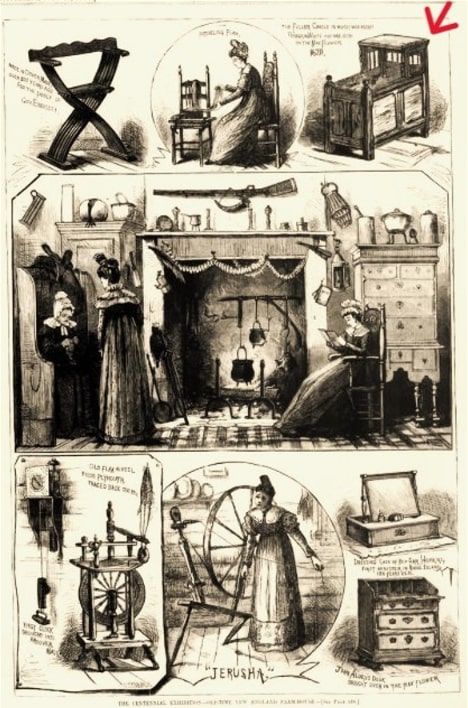
To further clarify the Fuller cradle’s accurate history furnished by Pilgrim Hall: it was probably made in Duxbury, Massachusetts, between 1680-1720, and descended into the family of Samuel Fuller. Thus, it did not arrive in the Mayflower in 1620 but nevertheless it is a true Pilgrim relic!
Explore over 330 years of newspapers and historical records in GenealogyBank. Discover your family story! Start a 7-Day Free Trial
Note on the header image: “Mayflower in Plymouth Harbor,” by William Halsall, 1882. Credit: Wikimedia Commons.
Related Article:
